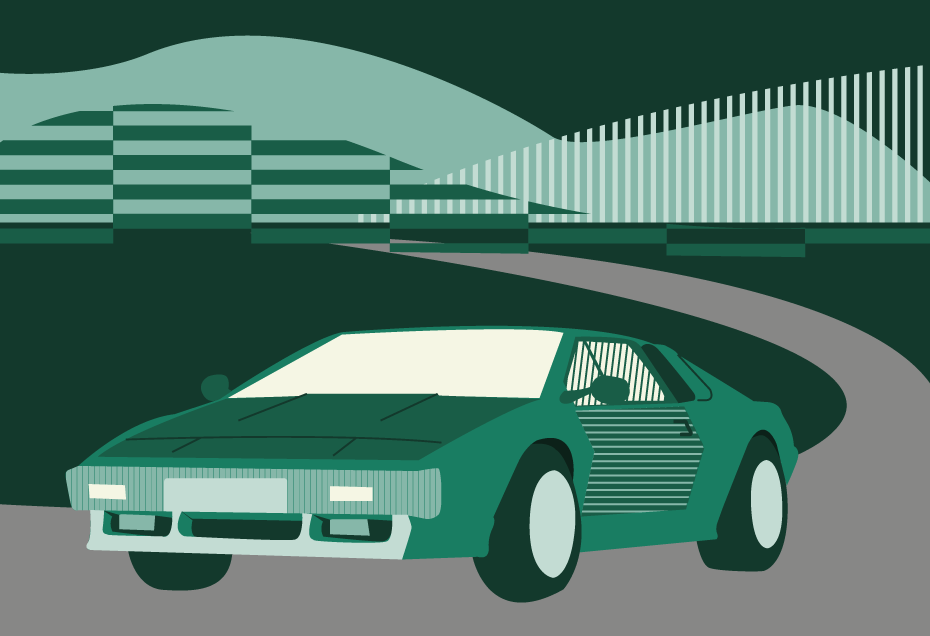Wedges were all the rage in the 1970s and 80s, but of all the low-slung, pointy sports cars produced it’s the Lotus Esprit that holds a special place in the hearts of British motoring fans.
For it marked the point at which a world-famous specialist car-maker from a tiny Norfolk village truly started to compete with the likes of Ferrari and Lamborghini – and it still looks sensational today, 40 years after Colin Chapman gave the green light to its production.
We look back at the most versatile Bond car of them all.
As a teenage boy in Norwich, the obligatory school trip to the chocolate factory (now a shopping mall) was only bettered by the outing to Hethel, the home of Lotus cars.
I knew nothing of torque, brake horse power or steel backbone chassis in those days, but I did recognise the rakish automotive beauty of a home-grown supercar contender when I saw it.
The series 3 Esprit in production at the time was so low, so bathed in leather, so sleek and so damn sexy, it couldn’t fail to leave a lasting impression on this goggle-eyed schoolboy – even though there was no free chocolate on offer.

Sadly, the closest I’ve come to ownership remains the swatch of leather I picked up from a parts bin in the factory, but the good news is that you can still buy a tidy Esprit for around £15,000 – a real bargain compared with the eye-watering cost of a contemporary Porsche 911, and considerably more rare.
The Esprit story began in 1972 with a Giugiaro-designed concept car based on a stretched Europa chassis, with the finished car launched three years later at the Paris Motor Show.
At its launch, Motorsport magazine described the Esprit as “the most exciting, attractive, series production British sports car to appear since the E-type in 1961”. High praise indeed.
“Truly, Lotus have excelled themselves with the Esprit, at last producing another true enthusiast’s car to replace the S130, Elan and Europa,” the magazine gushed.

The series 1, glass-fibre and plastic-bodied Esprit used Lotus’ 907, 2-litre powerplant, producing 160bhp – hardly impressive by today’s standards until you realise the car weighed under 1,000kg.
Lotus claimed 0-60 in under seven seconds and a top speed of 138mph, which propelled it into a sub-Ferrari class (but more of its true supercar claims later).
The mid-engined two-seater, boasting a nearly flat windscreen and spacious interior, used the impressive Citroen SM, Maserati-built 5-speed gearbox, but it was the roadholding that truly grabbed the headlines when road testers got their hands on the car.
In 1977, Motor said: “The traction is almost beyond compare in a road car, even better than that of a Porsche, especially in the wet. The limit of adhesion on dry surfaces is astonishing and even on wet roads it is very impressive.”
Autocar praised “quite outstanding roadholding and there are few cars that could stay with an Esprit in a hurry”.
The most famous series 1 of all was the submarine Bond car that 007 drove in an extended action sequence in The Spy Who Loved Me, avoiding pursuit by road and air by submerging and taking the battle to the seas.
The car featured wheel-arches that became fins, a periscope, torpedoes, surface-to-air missiles, mines and a black dye spray.
Tesla founder Elon Musk bought the car in 2013 for a whopping £650,000.
Grumblings about the cooling system of the series 1 were addressed with the introduction of the series 2 in 1978, with new intake and cooling duct joining a repositioned battery, Rover SD1 rear lights and an integrated front spoiler as changes from the launch model.
In 1980, a more torquey engine was introduced as a stopgap before the launch of the series 3 a year later, but it was the first factory-produced turbo version that helped the march towards true supercar territory.
Adrian Flux Classic Car Insurance
The Essex Turbo, a special edition to tie in with Essex Petroleum’s sponsorship of the Lotus F1 team, saw power increase to 210bhp, 0-60 in 6.1 seconds and a top speed of nearly 150mph, and heralded full production of the Turbo Esprit as part of the series 3 range.
The series 3 was the final incarnation of the Giugiaro-designed Esprit, the Turbo featuring the bodykit from the Essex cars and the standard S3 gaining wider, lower-profile tyres and larger rear wheels, improving the already stunning handling.
In 1987, the Esprit gained a more modern, even sleeker set of clothes courtesy of designer Peter Stevens, who went on to design the McLaren F1.
And it was this car that propelled the Esprit, in the shape of the new Turbo, into a true supercar competitor, as Autocar was quick to point out: “The new Esprit Turbo is in Porsche 911 and Ferrari 328 territory. Be in no doubt, the new Lotus is blisteringly quick.
“With a rare blend of ride and handling plus exceptional stability at all speeds it devours miles on winding backroads or sweeping autobahns alike.”

Despite the new car having essentially the same engine as the old Turbo, the slippery new body ensured the Esprit became the first Lotus to top 150mph, hitting 60mph in a shade over 5 seconds.
Autocar again: “The Esprit Turbo has many points in its favour. Searing performance, a chassis and brakes to match and sensational looks are only part of it. You also get acceptable fuel economy, a fine ride with very little road noise and reasonable luggage space for a two-seater.”
And Lotus wasn’t finished with Esprit yet: in 1989, the company introduced an even faster version in the shape of the SE, with power up to 264bhp, top speed to 160mph and 0-60 in just 4.7 seconds.
Success in the American supercar racing series resulted in the Sport 300, with improved brakes and suspension to cope with the 300bhp output.
The third redesign in 1993 saw further evolution of the same basic shape as the original, with Julian Thompson changing spoilers, bumpers and side skirts to bring the model up to date.
And by 1994, with 300bhp now standard, the car was now capable of 168mph and 0-60 in just 4.6 seconds – a true supercar.
An even faster turbo-charged V8 was added to the range in 1996 before the ultimate Esprit arrived in 1999 – the Sport 350, a limited edition run of 50 cars and the quickest Esprit of all with a 0-60 time of 4.3 seconds.
Dubbed by Lotus “the most extreme version of the Esprit ever to reach the market”, Autocar also called it “the most outrageous, visually as well as financially – not to mention the most exclusive”.
Staggering in-gear performance put the Sport 350 “on level terms with all but the fastest superbikes and, therefore, comfortably ahead of most four-wheeled rivals. By any standards it is a ferociously, addictively fast car.”
However, the car had some flaws as a road car, despite its outlandish performance, with a poor gearchange and more uncompromising ride than any Esprit of the past.
And this was to be the last of the line of arguably the greatest British supercar after a 28-year run and 10,675 cars sold – sadly, the stunning new Esprit unveiled at the 2010 Paris Motor Show and scheduled for 2014 was cancelled and, despite persistent online rumours since, there is no sign of its resurrection.
Like our illustration of the Lotus Esprit at the beginning of the article?
Download a free high-quality poster version here.
These days, it’s far more exclusive, if a little less polished and reliable, than a 911, and there are bargains to be had for dedicated Esprit devotees prepared to give these cars the love they need, and deserve.
Insurance from Adrian Flux
Get competitive classic car insurance for the Lotus Esprit with Adrian Flux.
Features can include:
- Agreed value
- Limited mileage discounts
- Owners club discount
- Laid up cover
- Wedding hire cover











